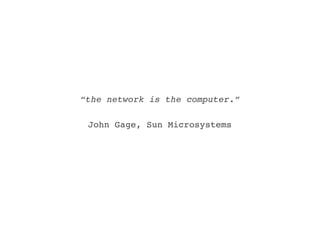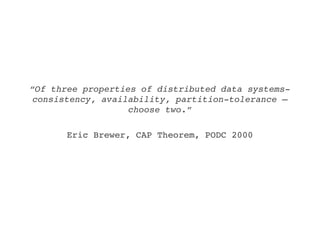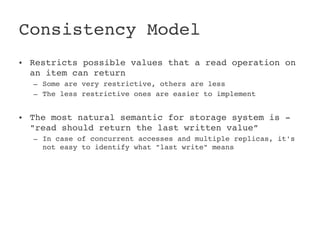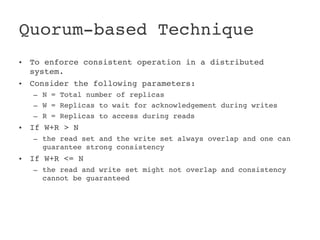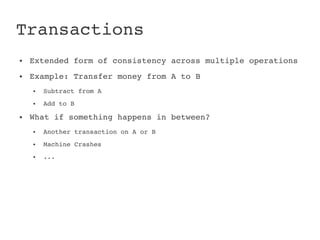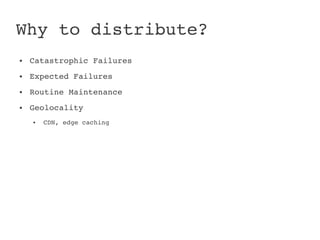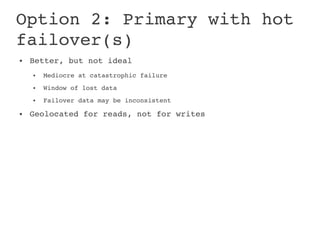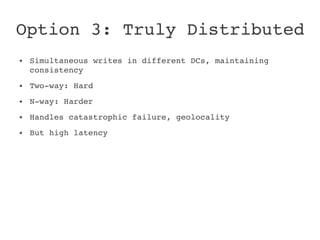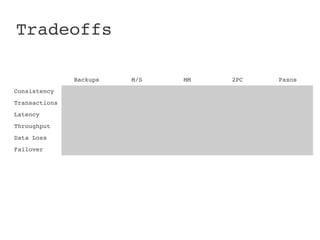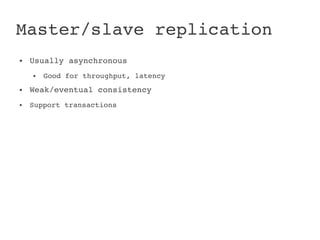Designing large scale distributed systems
- 1. Designing LargeScale Distributed Systems Ashwani Priyedarshi
- 3. “A distributed system is one in which the failure of a computer you didn’t even know existed can render your own computer unusable.” Leslie Lamport
- 4. “Of three properties of distributed data systems consistency, availability, partitiontolerance – choose two.” Eric Brewer, CAP Theorem, PODC 2000
- 5. Agenda ● Consistency Models ● Transactions ● Why to distribute? ● Decentralized Architecture ● Design Techniques & Tradeoffs ● Few Real World Examples ● Conclusions
- 6. Consistency Model • Restricts possible values that a read operation on an item can return – Some are very restrictive, others are less – The less restrictive ones are easier to implement • The most natural semantic for storage system is "read should return the last written value” – In case of concurrent accesses and multiple replicas, it's not easy to identify what "last write" means
- 7. Strict Consistency ● Assumes the existence of absolute global time ● It is impossible to implement on a large distributed system ● No two operations (in different clients) allowed at the same time ● Example: Sequence (a) satisfies strict consistency, but sequence (b) does not
- 8. Sequential Consistency ● The result of any execution is the same as if ● the read and write operations by all processes on the data store were executed in some sequential order ● the operations of each individual process appear in this sequence in the order specified by its program ● All processes see the same interleaving of operations ● Many interleavings are valid ● Different runs of a program might act differently ● Example: Sequence (a) satisfies sequential consistency, but sequence (b) does not
- 9. Consistency vs Availability • In large shareddata distributed systems, network partitions are a given • Consistency or Availability • Both options require the client developer to be aware of what the system is offering
- 10. Eventual Consistency • An eventual consistent storage system guarantees that if no new updates are made to the object, eventually all accesses will return the last updated value • If no failures occur, the maximum size of the inconsistency window can be determined based on factors such as: – load on the system – communication delays – number of replicas • The most popular system that implements eventual consistency is DNS
- 11. Quorumbased Technique • To enforce consistent operation in a distributed system. • Consider the following parameters: – N = Total number of replicas – W = Replicas to wait for acknowledgement during writes – R = Replicas to access during reads • If W+R > N – the read set and the write set always overlap and one can guarantee strong consistency • If W+R <= N – the read and write set might not overlap and consistency cannot be guaranteed
- 12. Agenda ● Consistency Models ● Transactions ● Why to distribute? ● Decentralized Architecture ● Design Techniques & Tradeoffs ● Few Real World Examples ● Conclusions
- 13. Transactions ● Extended form of consistency across multiple operations ● Example: Transfer money from A to B ● Subtract from A ● Add to B ● What if something happens in between? ● Another transaction on A or B ● Machine Crashes ● ...
- 14. Why Transactions? ● Correctness ● Consistency ● Enforce Invariants ● ACID
- 15. Agenda ● Consistency Models ● Transactions ● Why to distribute? ● Decentralized Architecture ● Design Techniques & Tradeoffs ● Few Real World Examples ● Conclusions
- 16. Why to distribute? ● Catastrophic Failures ● Expected Failures ● Routine Maintenance ● Geolocality ● CDN, edge caching
- 17. Why NOT to distribute? ● Within a Datacenter ● High bandwidth: 1100Gbps interconnects ● Low latency: < 1ms within a rack, < 5ms across ● Little to no cost ● Between Datacenters ● Low bandwidth: 10Mbps1Gbps ● High latency: expect 100s of ms ● High Cost for fiber
- 18. Agenda ● Consistency Models ● Transactions ● Why to distribute? ● Decentralized Architecture ● Design Techniques & Tradeoffs ● Few Real World Examples ● Conclusions
- 19. Decentralized Architecture ● Operating from multiple datacenters simultaneously ● Hard problem ● Maintaining consistency? Harder ● Transactions? Hardest
- 20. Option 1: Don't ● Most common ● Make sure datacenter never goes down ● Bad at catastrophic failure ● Large scale data loss ● Not great for serving ● No geolocation
- 21. Option 2: Primary with hot failover(s) ● Better, but not ideal ● Mediocre at catastrophic failure ● Window of lost data ● Failover data may be inconsistent ● Geolocated for reads, not for writes
- 22. Option 3: Truly Distributed ● Simultaneous writes in different DCs, maintaining consistency ● Twoway: Hard ● Nway: Harder ● Handles catastrophic failure, geolocality ● But high latency
- 23. Agenda ● Consistency Models ● Transactions ● Why to distribute? ● Decentralized Architecture ● Design Techniques & Tradeoffs ● Few Real World Examples ● Conclusions
- 24. Tradeoffs Backups M/S MM 2PC Paxos Consistency Transactions Latency Throughput Data Loss Failover
- 25. Backups ● Make a copy ● Weak consistency ● Usually no transactions
- 26. Tradeoffs – Backups Backups M/S MM 2PC Paxos Consistency Weak Transactions No Latency Low Throughput High Data Loss High Failover Down
- 27. Master/slave replication ● Usually asynchronous ● Good for throughput, latency ● Weak/eventual consistency ● Support transactions
- 28. Tradeoffs – Master/Slave Backups M/S MM 2PC Paxos Consistency Weak Eventual Transactions No Full Latency Low Low Throughput High High Data Loss High Some Failover Down Read Only
- 29. Multimaster replication ● Asynchronous, eventual consistency ● Concurrent writes ● Need serialization protocol ● e.g. monotonically increasing timestamps ● Either with master election or distributed consensus protocol ● No strong consistency ● No global transactions
- 30. Tradeoffs Multimaster Backups M/S MM 2PC Paxos Consistency Weak Eventual Eventual Transactions No Full Local Latency Low Low Low Throughput High High High Data Loss High Some Some Failover Down Read Only Read/write
- 31. Two Phase Commit ● Semidistributed consensus protocol ● deterministic coordinator ● 1: Request 2: Commit/Abort ● Heavyweight, synchronous, high latency ● 3PC: Asynchronous (One extra round trip) ● Poor Throughput
- 32. Tradeoffs 2PC Backups M/S MM 2PC Paxos Consistency Weak Eventual Eventual Strong Transactions No Full Local Full Latency Low Low Low High Throughput High High High Low Data Loss High Some Some None Failover Down Read Only Read/write Read/write
- 33. Paxos ● Decentralized, distributed consensus protocol ● Protocol similar to 2PC/3PC ● Lighter, but still high latency ● Three class of agents: proposers, acceptors, learners ● 1. a) prepare b) promise 2. a) accept b) accepted ● Survives minority failure
- 34. Tradeoffs Backups M/S MM 2PC Paxos Consistency Weak Eventual Eventual Strong Strong Transactions No Full Local Full Full Latency Low Low Low High High Throughput High High High Low Medium Data Loss High Some Some None None Failover Down Read Only Read/write Read/write Read/write
- 35. Agenda ● Consistency Models ● Transactions ● Why to distribute? ● Decentralized Architecture ● Design Techniques & Tradeoffs ● Few Real World Examples ● Conclusions
- 36. Examples ● Megastore ● Google's Scalable, Highly Available Datastore ● Strong Consistency, Paxos ● Optimized for reads ● Dynamo ● Amazon’s Highly Available Keyvalue Store ● Eventual Consistency, Consistent Hashing, Vector Clocks ● Optimized for writes ● PNUTS ● Yahoo's Massively Parallel & Distributed Database System ● Timeline Consistency ● Optimized for reads
- 37. Conclusions ● No silver bullet ● There are no simple solutions ● Design systems based on application needs
- 38. The End
- 40. Backup Slides
- 41. Vector Clocks • Used to capture causality between different versions of the same object. • A vector clock is a list of (node, counter) pairs. • Every version of every object is associated with one vector clock. • If the counters on the first object’s clock are lessthanorequal to all of the nodes in the second clock, then the first is an ancestor of the second and can be forgotten.
- 43. Partitioning Algorithm • Consistent hashing: – The output range of a hash function is treated as a fixed circular space or “ring”. • Virtual Nodes – Each node can be responsible for more than one virtual node. – When a new node is added, it is assigned multiple positions. – Various Advantages


